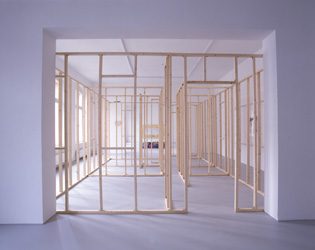Born 1971 in Lima, Peru; lives in Houston, Texas, Miami, Florida, and New York, New York
William Cordova’s work is tied to an urban ecology of obsolescence, disparity, and displacement. Busted cars, trashed tires, discarded shoes, machetes, speakers, and books yellowed with age provide the material support and iconographic program for his drawings, collages, and installations. For the artist, these material choices reference the reality of lived experience, as opposed to the spectacle of culture, mass-produced for constant consumption. The fluency with which Cordova traverses media and remixes cultural signifiers confirms his visual multilinguism, as barbed as it is lived-in.
The range of Cordova’s sources is strikingly evident in the titles of works like Medgar Evers (2005), daniel boone, pat boone & mary boone (y los Olmec’s?) (2006), and Arrow of god (4-chinua achebe) (2006). His rapaciousness shows as well in his frequent use of color symbols, as in the red and black in O. T. atsinadnas (2007), at once referring to the colors of the Sandinista flag, a politically charged image for some viewers, and existing purely as formal composition. As an extension of his individual artistic practice, Cordova has collaborated with fellow artist/writer Leslie Hewitt through their BASE collective on projects such as I Wish It Were True (for more information about this project, please see Hewitt’s artist entry in this catalogue). Another project, From the Root (2006–), utilizes existing billboards to activate dialogue within their respective communities by listing names of activists in an anti-chronological and -hierarchical fashion.
Cordova has been preoccupied with issues of transformation and interpretation since his youth, owing partly to his own transitions between countries, economies, and languages. Having recently moved from Lima to Miami, the six-year-old found comfort in the sight of what he thought were familiar Peruvian cajón drums scattered on the streets, but which were in fact discarded speaker boxes. The hulking Badussy (or Machu Picchu after dark) (2004–05) dominates the gallery with some two hundred old speakers stacked to suggest a pre-Columbian monolith. Similarly addressing the fragility of history through an ephemeral environment, The House that Frank Lloyd Wright built 4 Fred Hampton and Mark Clark (2006), shown at Arndt & Partner Berlin in 2006, is a dizzying room-scale labyrinth of wooden beams based on the footprint of the house where Black Panthers Fred Hampton and Mark Clark were killed by Chicago police in a predawn raid in 1969. Much of Cordova’s work induces similarly uncanny interpretive spirals, abetted not by arbitrary Surrealist juxtapositions but the all-too-common strangeness of our own detritus and the too-often repressed histories they conceal. SUZANNE HUDSON
William Cordova, The House that Frank Lloyd Wright built 4 Fred Hampton and Mark Clark, 2006 (installation view, Arndt & Partner, Berlin, 2006). Wood, books and suspended drawing, dimensions variable. Collection of the artist; courtesy Arndt & Partner Berlin
























